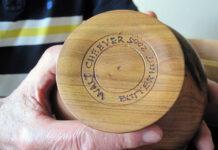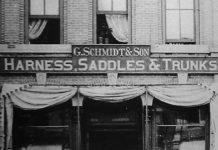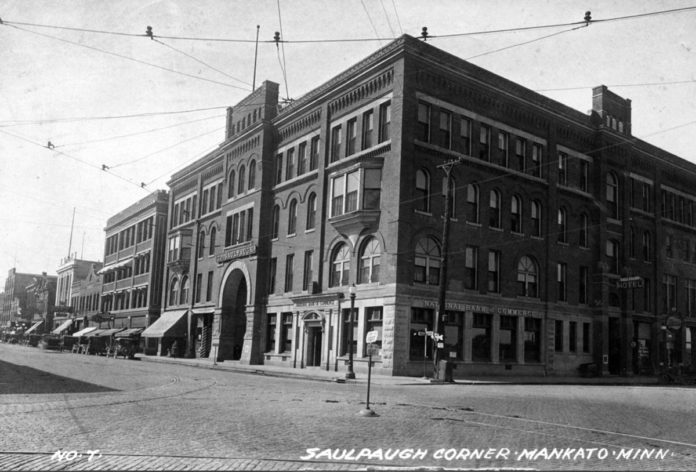
Just mentioning the name “Saulpaugh Hotel” brings to mind visions of a grand time in Mankato’s history. This stately hotel, built in 1888, was once said to have marked Mankato’s transition from a town of wooden buildings and dirt streets to a city of stone and pavement.
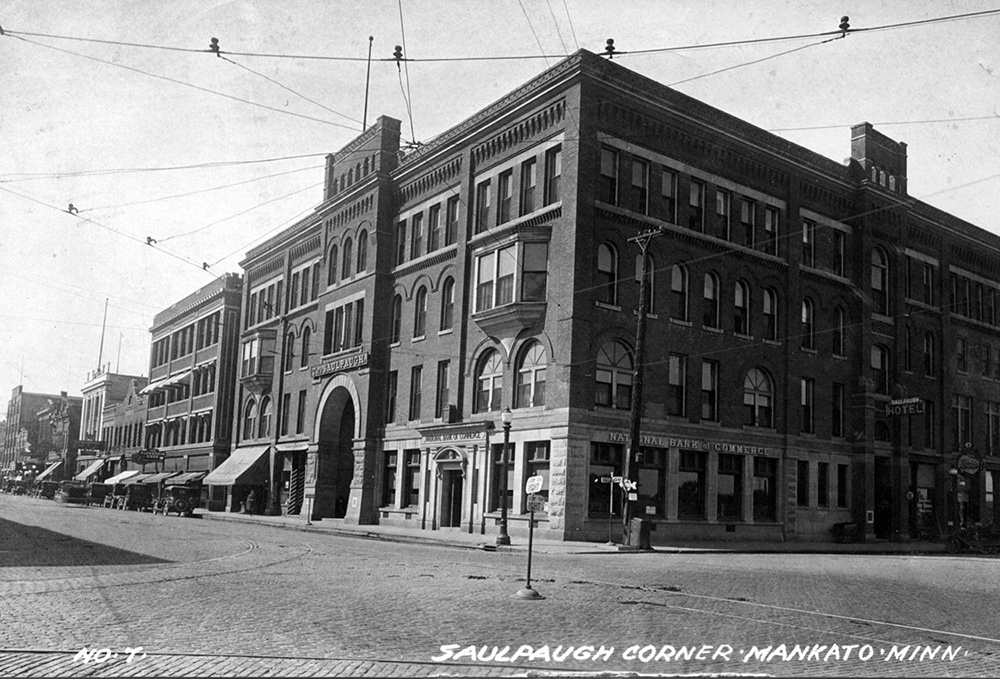
The hotel was built by Thomas Saulpaugh, a construction company owner who came to Mankato in search of quarries to provide him with stone for the railroad bridges he built. Saulpaugh paid $14,000 for the property on Front Street, and the hotel itself cost $142,000, more than the Blue Earth County Courthouse, which was built the same year and cost $123,000.
The original entrance to the hotel faced the Minnesota River, and many patrons arrived by steamboat or train.
A Grand Hotel
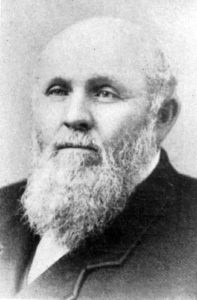
The hotel’s grand opening on November 6, 1889, was an elaborate social event with a reception and banquet attended by the famous of the time. Governor William Rush Merriam was one of the first to sign the hotel’s guest register.
Thomas Saulpaugh died in 1893, just a few years after the hotel opened.
His son, Clarence owned the hotel for the next 24 years with Fred Snyder as manager. Clarence was one of the first automobile owners in Mankato. On April 19, 1902, the Mankato Review reported his arrival from Minneapolis in his new automobile, “He made a grand entrée into the city and was enthusiastically cheered along entire Main Street.”
Clarence and his wife, Roma had no children and they lived in an apartment in the hotel. When Clarence died in 1917, his funeral was held in the center alcove on the second floor of the hotel.
This stately hotel, built in 1888, was once said to have marked Mankato’s transition from a town of wooden buildings and dirt streets to a city of stone and pavement.
The large four-story hotel contained 80 elegantly furnished guest rooms. On the ground floor was the office, barbershop, baggage and reception rooms, a large reading room, billiard hall and bar, telegraph room, and restrooms. The hotel was heated by steam and lighted by electricity and gas. It boasted one of the “best improved” passenger and baggage elevators.
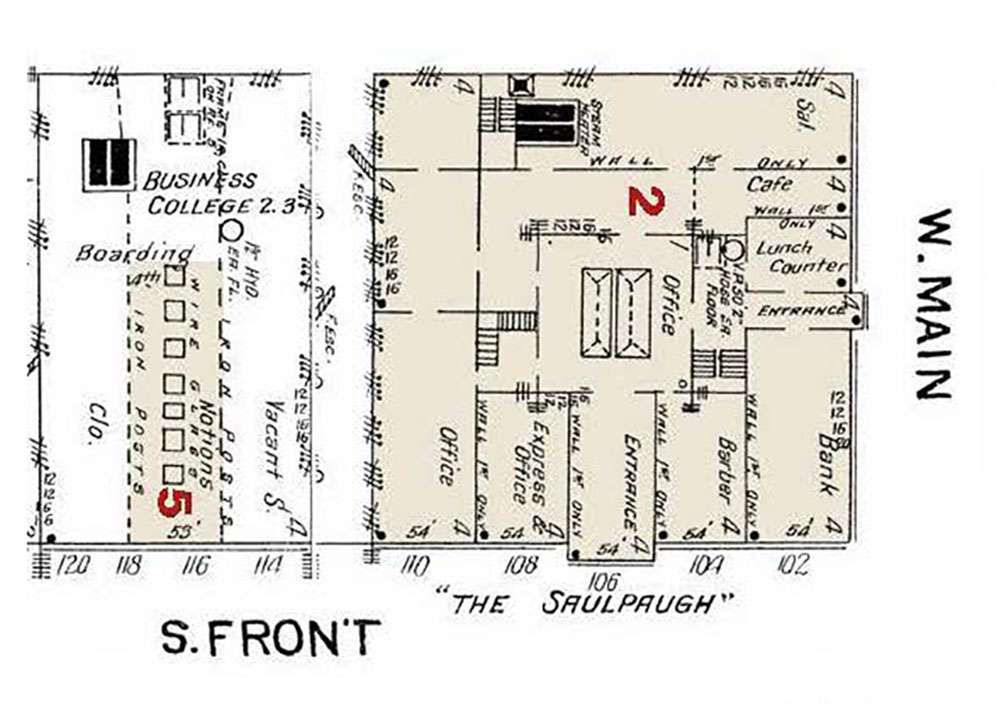
Through its early years of operation, the Saulpaugh was a popular gathering place. In the Gay Nineties the hotel was the setting for most parties of the Cotillion Club. Designed with many parlors, wide corridors, and a grand ballroom overlooking the river, the hotel had no equal luxury as a background for these events.
A Well Known Landmark
Mankato-born author, Maud Hart Lovelace was a young girl when the hotel was in its prime. When she wrote the Betsy-Tacy books, Maud used the Saulpaugh Hotel as a setting in Betsy and Tacy Go Downtown, although she gives it the fictional name, Melborn Hotel. Her descriptions of the hotel capture the spirit of the place and brings to life this period of time.
“At the top of the stairs stretched the hotel dining room. It was two stories high and overlooked the river. Here Deep Valley gave its fashionable parties, its dances and cotillions, with an orchestra playing behind potted palms and those guests who did not care to dance amusing themselves with whist and euchre in the luxurious parlors.” Betsy and Tacy Go Downtown
The hotel attracted its share of the famous as well. President Howard Taft stayed overnight in 1911. In the 1930s John Dillinger’s cohorts allegedly stayed at the Saulpaugh, which prompted FBI agents to investigate and search the hotel for the notorious gangster.
Lowell Johnson
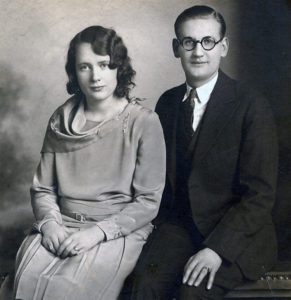
Lowell Johnson can remember the grand old hotel better than most. He lived and worked at the hotel during the early years of his life. Lowell’s parents, Floyd Johnson and Grace Maxfield met at the hotel in the 1920s when Grace was a waitress at the Blue Blazer Café. Floyd was attending Mankato Commercial College and was working at the hotel as a clerk. They were married in 1928 and their wedding reception was held at the hotel ballroom.
Many of the hotel employees lived in the hotel as did Mr. and Mrs. Johnson. Their only son, Lowell was born in 1935 and the first five years of his life were spent in rooms 146-148. These rooms were located at the backside of the building.
Lowell recalled, “There was a whole city in the Saulpaugh. I got my first haircut in Cy St. Peter’s Barber Shop, which was right off the lobby. Frank Daniels had an insurance company – Frank later served as mayor of North Mankato. Frank Abraham had Abe’s Shoe Shine Parlor where I had my first shoe shine, and Mel Owens sold hats. There was Scotty’s Cigar Stand, a Western Union office and the National Bank of Commerce was housed in the building. I remember the steam engines back then and how they would make the windows rattle in the hotel.”
“I remember stories of an old criminal who lived at the hotel when I was young,” Johnson continued. “His name was Jack Kooser. Kooser didn’t like the furniture in his hotel room so he bought his own. I think he might have got shot over in Wisconsin. He used to sit in the lobby chair positioned so he could see the front door and the side door.”
It really bothered my mother when they tore down the hotel. She always said that the most important things that happened in her life, happened in the Saulpaugh.Lowell Johnson
After checking files at the Blue Earth County Historical Society, newspaper headlines from August 1935 report Kooser’s death – “Jack Kooser Found Dead on Highway – Mankato Racketeer is Victim of Usual Underworld Fate.” The article lists his address as the Saulpaugh Hotel.
The Saulpaugh Hotel became one of many hotels owned and operated by Arthur L. Roberts Hotels in the 1930s. Roberts owned hotels in Winona, Rochester, St. Paul, Minneapolis, St. Cloud, Stillwater, Hastings, Brainerd and Fergus Falls, Minnesota, as well as several in Michigan, Wisconsin, Indiana, Montana and North Dakota.
In 1940 Floyd Johnson was transferred to manage the Grand Central Hotel in St. Cloud for two years and later the St. Cloud Hotel. The Johnson family of three lived in these hotels until moving back to Mankato in 1947, when Floyd began working for Arthur L. Roberts Hotels as an accountant traveling to the various hotels they owned. This time the family lived in a house on East Vine Street. In the late 1940s Floyd came back to work as the manager of the hotel.
“My first job at the hotel was a bell hop when I was in high school in the early 1950s,” Lowell recalled. He earned 35¢ an hour plus tips and his supper meal. After school he’d walk from Mankato High School (now Mankato West High) to the Saulpaugh and work two hours during the busy check in time which was from 4:00-6:00 pm. He worked in nearly every area including as a houseboy helping the maids, custodian, elevator operator, dish washer and even working in the laundry. “I was a night clerk when I went to college working eight hours a day. What little studying I did, I did behind the hotel desk,” Johnson said.
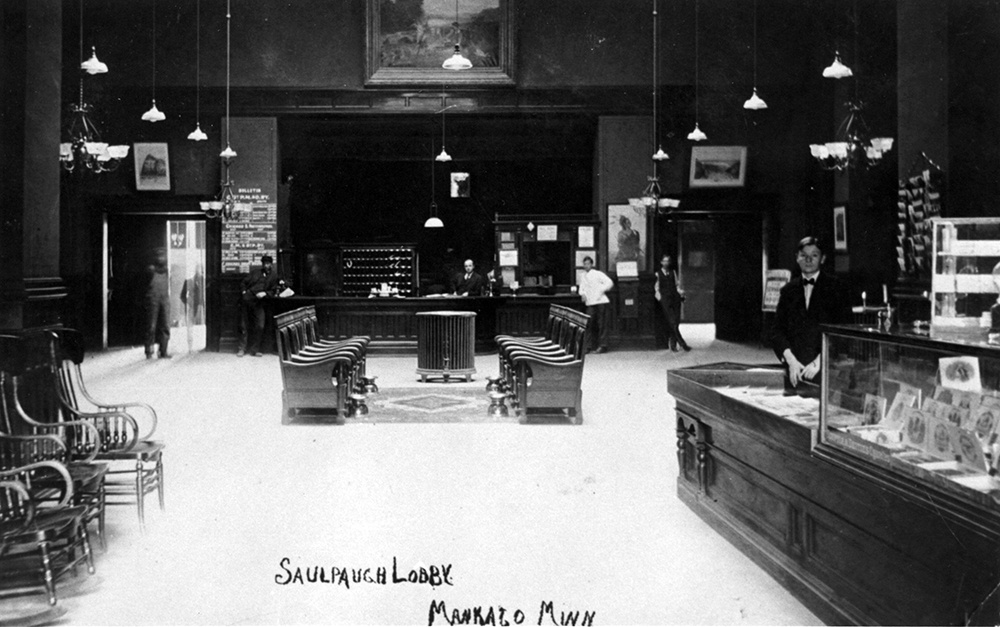
The hotel had a huge lobby with big, overstuffed chairs. “On Sundays when I was young, we’d go around and sit in the chairs and look for change that had fallen down in them,” Johnson recalled.
The Building
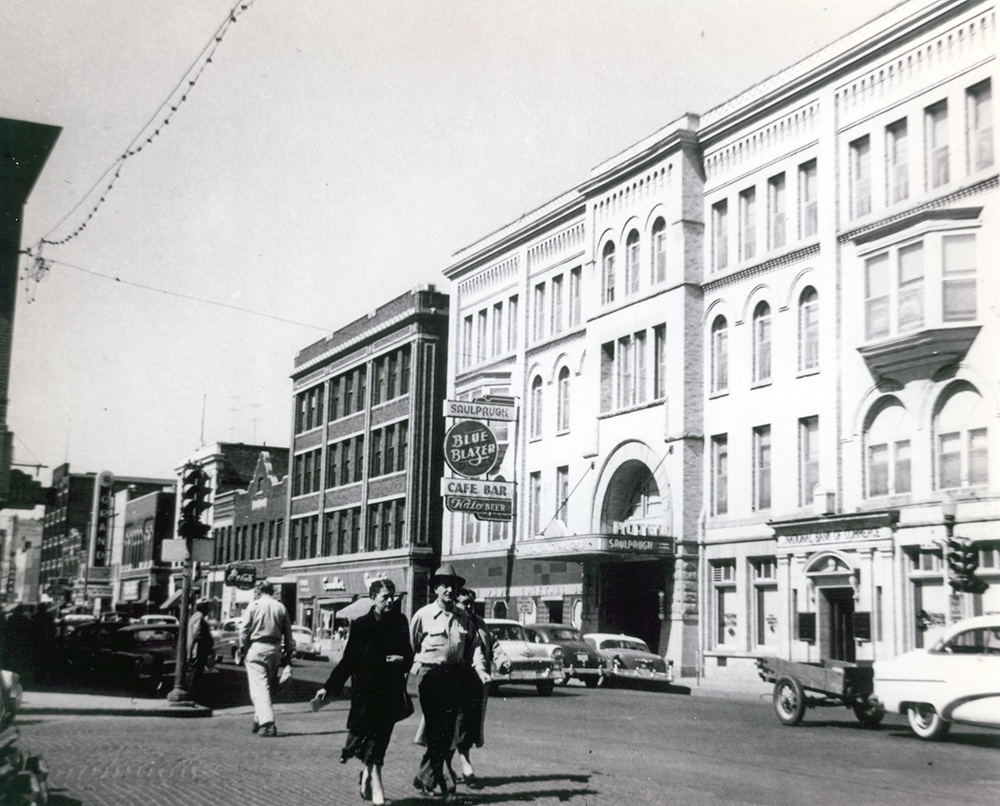
The lobby was brightened by a square stained-glass skylight with an “S” in it. A large wooden desk with a marble top had a slot cut out to deposit mail. Behind the desk was a beauty parlor and a public restroom that required a nickel or dime to use. There were two beautiful staircases with open railings, one on each side of the entrance.
“People walking across the Main Street Bridge from North Mankato used to take a short cut through the hotel, especially in the winter when it was cold. They came in through the side entrance, walked through the lobby and exited through the front entrance doors. It kept Joe Cuddy, the custodian busy!” said Johnson. The lobby had terrazzo tile floors.
The building was heated by steam from large boilers that were fueled by coal and operated
by two engineers. Later gas was added and the building could be heated by gas or coal. If it
got really cold, they switched to all coal. The coal was delivered by truck and dropped in a
coal chute in the back of the building.
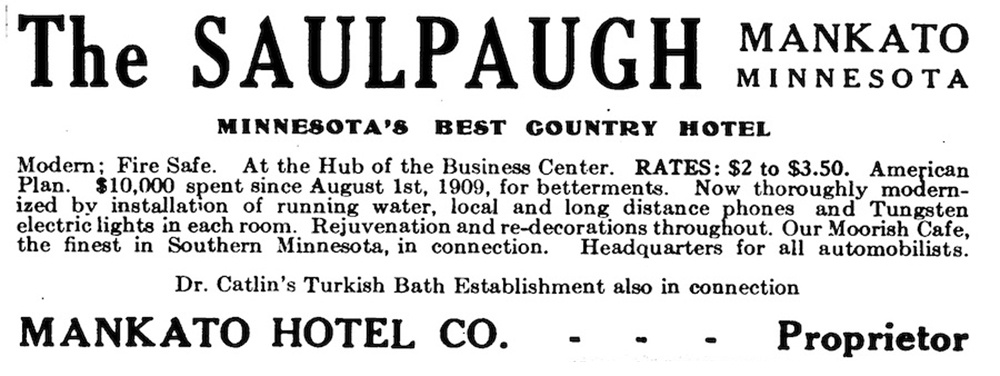
The first floor of the hotel or the mezzanine had the main ballroom, a smaller ballroom, a small dining room and a small room used to serve food. There were no sleeping rooms on the mezzanine. The second floor had the larger better rooms with baths and the third floor had most of the smaller, plain rooms. The plain rooms held only a bed, dresser and a sink. There were public showers on both floors.
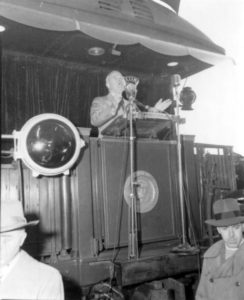
Rates in 1910 were advertised as $2.00 to $3.50. By the early 1950s, rates were still $2.00 for the plain rooms or $4.50-$5.50 for rooms with baths. Laundry was done in the basement for many years. Later it was sent out to Johnson’s Laundry.
The Chicago Northwestern Railroad always had three rooms on the second floor reserved for their linemen. “One event I remember very well is when we had secret service men up on the roof when President Truman came to town,” Johnson remembered. “The special presidential train stopped at the depot and the President spoke from the back end of the railroad car. My dad was manager then and it was quite a big deal.” Mankato newspaper reports claim 8,000-10,000 gathered to hear the president speak on October 12, 1948.
The Blue Blazer Café
The Blue Blazer Café was one of the best places to eat in town and for many years was run by Silva Sampson whom everyone called “Sammy.” Ray Miller was the chef and his wife, Lucille worked in the kitchen.
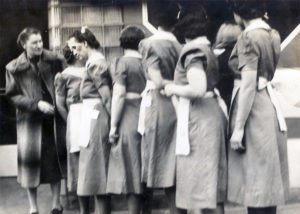
There was an employee dining room just off the kitchen where most of the people who worked at the hotel ate their meals. “I didn’t eat many meals at home. Every morning my dad stopped in the café and never had to order — they just brought him tomato juice, toast and coffee and that’s all he ever had for breakfast. His meals were part of his salary and he always ate supper at the hotel before he came home in the evening,” said Johnson.
Service clubs, such as the Lions and the Rotary Clubs used to meet at the hotel for lunch. The Blue Blazer Café was well-known for its prime rib.
“Louie Salet, owner of Salet’s Department Store, always ate lunch at the Blue Blazer,” Johnson added. Salet had well-trained police dogs that were left in his store at night. Louie would bring his dogs to the hotel and position them right by the door and tell them to stay. You couldn’t move those dogs for anything! One of Louie’s favorite meals was liver, which was always served with bacon strips on the top. Louie, being of the Jewish faith, did not eat pork and fed the bacon to his dogs.”
Not only did many of the hotel employees eat their meals at the hotel, but about a third of them lived there also. After Lowell left home, his parents moved back to live in the hotel in Room 218.
Changing Times
Over the years transportation and tourism changes affected the hotel’s business. New highways and freeways brought motels to Mankato, which catered to automobiles. An automobile entrance was built into the Saulpaugh’s north side. However, business continued to decline.
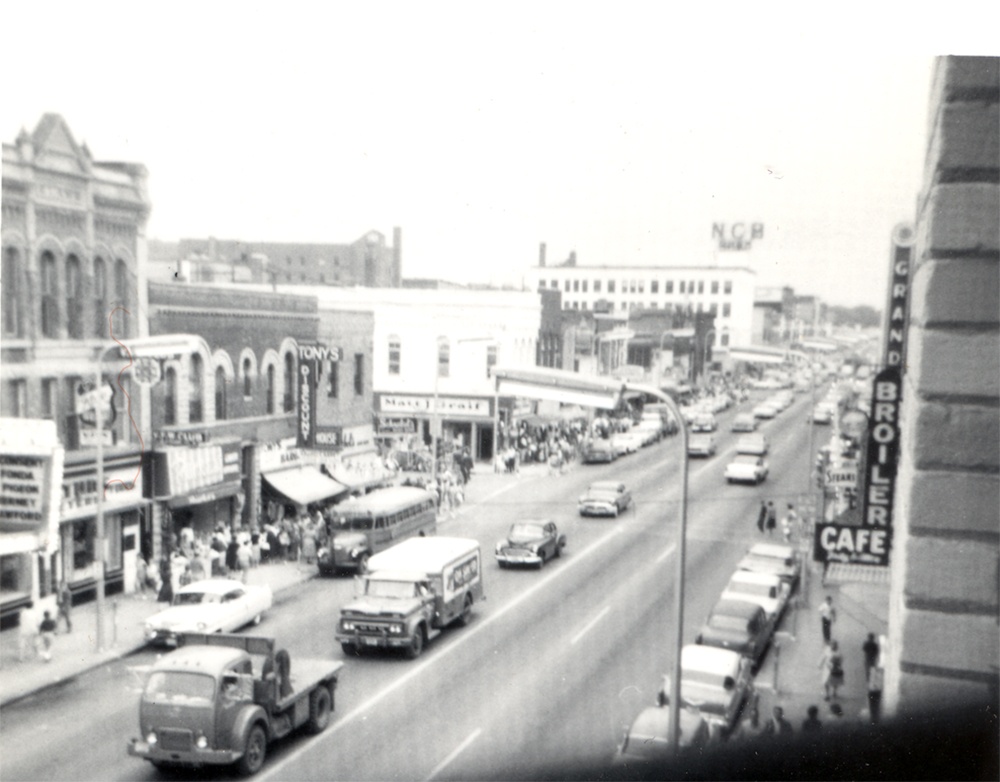
When Arthur L. Roberts Hotels sold the Saulpaugh to a couple of businessmen from out of town, they bought it on the condition that Floyd Johnson stayed on as the manager. He continued to work as manager until the hotel was closed in 1964.
Afterward the building was used as a dormitory for girls attending Mankato Commercial College in the Martin building located next door. In 1970 the hotel building fell within the planned downtown redevelopment area when the Key City Urban Renewal Project was approved. The Saulpaugh Hotel was demolished in 1974.
“It really bothered my mother when they tore down the hotel. She always said that the most important things that happened in her life, happened in the Saulpaugh,” said Johnson.
Additional Links

